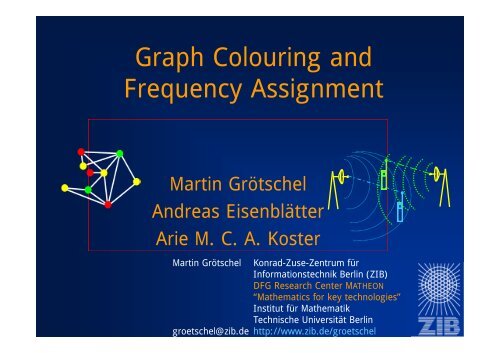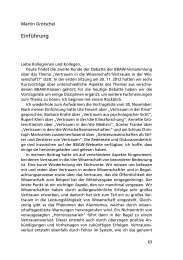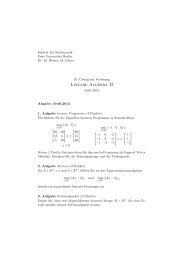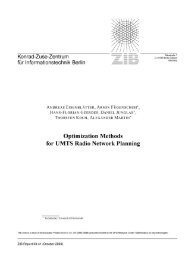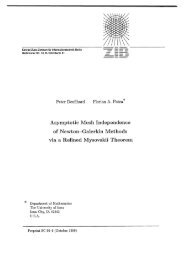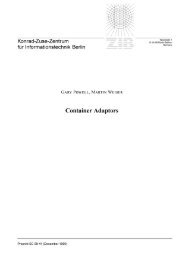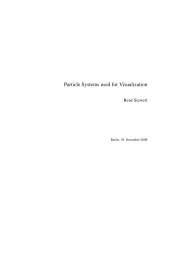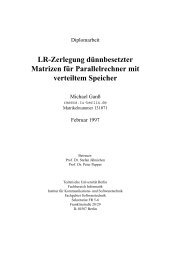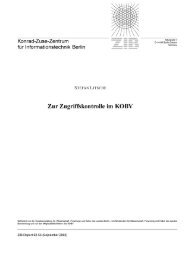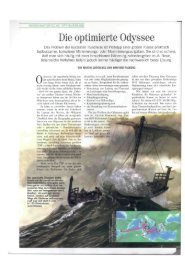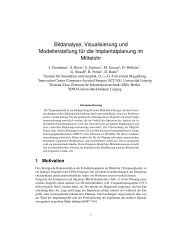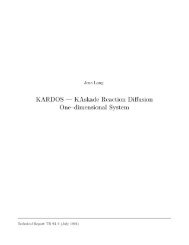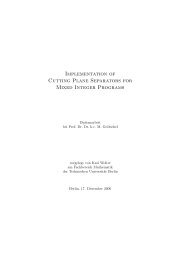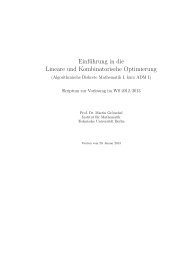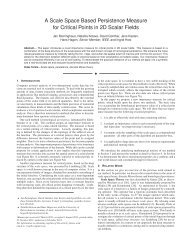PDF slides of "Graph Colouring and Frequency Assignment - ZIB
PDF slides of "Graph Colouring and Frequency Assignment - ZIB
PDF slides of "Graph Colouring and Frequency Assignment - ZIB
Create successful ePaper yourself
Turn your PDF publications into a flip-book with our unique Google optimized e-Paper software.
<strong>Graph</strong> <strong>Colouring</strong> <strong>and</strong><br />
<strong>Frequency</strong> <strong>Assignment</strong><br />
Martin Grötschel<br />
Andreas Eisenblätter<br />
Arie M. C. A. Koster<br />
Martin Grötschel Konrad-Zuse-Zentrum für<br />
Informationstechnik Berlin (<strong>ZIB</strong>)<br />
DFG Research Center MATHEON<br />
“Mathematics for key technologies”<br />
Institut für Mathematik<br />
Technische Universität Berlin<br />
groetschel@zib.de http://www.zib.de/groetschel
Coloring <strong>Graph</strong>s<br />
Given a graph G = (V,E), color the nodes <strong>of</strong> the<br />
graph such that no two adjacent nodes have the<br />
same color.<br />
The smallest number <strong>of</strong> colors with this property<br />
is called chromatic or coloring number <strong>and</strong> is<br />
denoted by χ(G)<br />
.<br />
Konrad-Zuse-Zentrum für Informationstechnik Berlin Martin Grötschel
Coloring <strong>Graph</strong>s<br />
A typical theoretical question: Given a<br />
class C <strong>of</strong> graphs<br />
(e.g., planar or perfect graphs, graphs without<br />
certain minors), what can one prove about the<br />
chromatic number <strong>of</strong> all graphs in C ?<br />
A typical practical question: Given a<br />
particular graph G<br />
(e.g., arising in some application), how can<br />
one determine (or approximate) the chromatic<br />
number <strong>of</strong> G?<br />
Konrad-Zuse-Zentrum für Informationstechnik Berlin Martin Grötschel
Coloring <strong>Graph</strong>s: Some History<br />
• 1852 Francis Guthrie: Can any map be<br />
colored using four colors?<br />
1879 “False Pro<strong>of</strong>” by Kempe<br />
1880 “False Pro<strong>of</strong>” by Tait<br />
etc.<br />
• 1890 Heawood “Map Color Theorem”<br />
(e. g., 7 colors suffice on the torus)<br />
1966 Pro<strong>of</strong> by Ringel & Youngs, see<br />
G. Ringel: Map Color Theorem”, Springer, 1974<br />
Konrad-Zuse-Zentrum für Informationstechnik Berlin Martin Grötschel
Coloring <strong>Graph</strong>s<br />
• The Four Color Problem<br />
Appel & Haken (1977) “Pro<strong>of</strong>” (Heesch)<br />
Appel & Haken (1986):<br />
This leaves the reader to face 50 pages containing text <strong>and</strong><br />
diagrams, 85 pages filled with almost 2500 additional diagrams,<br />
<strong>and</strong> 400 micr<strong>of</strong>iche pages that contain further diagrams <strong>and</strong><br />
thous<strong>and</strong>s <strong>of</strong> individual verifications <strong>of</strong> claims made in 24 lemmas<br />
in the main section <strong>of</strong> the text. In addition the reader is told that<br />
certain facts have been verified with the use <strong>of</strong> about 1200 hours<br />
<strong>of</strong> computer time <strong>and</strong> would be extremely time-consuming to<br />
verify by h<strong>and</strong>. The papers are somewhat intimidating due to their<br />
style <strong>and</strong> length <strong>and</strong> few mathematicians have read them in any<br />
detail.<br />
Konrad-Zuse-Zentrum für Informationstechnik Berlin Martin Grötschel
Coloring <strong>Graph</strong>s<br />
• The Four Color Problem<br />
Robertson, S<strong>and</strong>ers, Seymour & Thomas (1997)<br />
(on the run: coloring algorithm with quadratic running time)<br />
Robin Thomas: “An update <strong>of</strong> the four-color theorem”,<br />
Notices Amer. Math. Soc. 45 (1998) 848-859<br />
http://www.math.gatech.edu/~thomas/FC/fourcolor.html<br />
Konrad-Zuse-Zentrum für Informationstechnik Berlin Martin Grötschel
Coloring <strong>Graph</strong>s<br />
• R<strong>and</strong>om graph theory<br />
Very precise estimates for the chromatic number <strong>of</strong><br />
r<strong>and</strong>om graphs<br />
• Variations<br />
Edge coloring: Vizing’s Theorem (1964)<br />
List coloring<br />
T-coloring<br />
Konrad-Zuse-Zentrum für Informationstechnik Berlin Martin Grötschel
Coloring <strong>Graph</strong>s<br />
• Coloring, T-coloring, <strong>and</strong> list coloring<br />
graphs embedded on surfaces<br />
Carsten Thomassen<br />
Konrad-Zuse-Zentrum für Informationstechnik Berlin Martin Grötschel
Coloring <strong>Graph</strong>s<br />
• Coloring graphs algorithmically<br />
- NP-hard in theory<br />
- very hard in practice<br />
- almost impossible to find optimal colorings<br />
- playground for heuristics (e.g., DIMACS challenge)<br />
Konrad-Zuse-Zentrum für Informationstechnik Berlin Martin Grötschel
Coloring in Telecommunication<br />
• <strong>Frequency</strong> or Channel <strong>Assignment</strong> for<br />
radio-, tv-transmission, etc.<br />
• Our Example: Mobile phone systems<br />
• Andreas Eseinblätter, Martin Grötschel <strong>and</strong><br />
Arie M. C. A. Koster, Frequenzplanung im Mobilfunk,<br />
DMV-Mitteilungen 1(2002)18-25<br />
• Andreas Eisenblätter, Hans-Florian Geerdes, Thorsten Koch, Ulrich<br />
Türke: MOMENTUM Data Scenarios for Radio Network Planning <strong>and</strong><br />
Simulation , <strong>ZIB</strong>-Report 04-07<br />
• Andreas Eisenblätter, Armin Fügenschuh, Hans-Florian Geerdes,<br />
Daniel Junglas, Thorsten Koch, Alex<strong>and</strong>er Martin: Optimization<br />
Methods for UMTS Radio Network Planning, <strong>ZIB</strong>-Report 03-41<br />
Konrad-Zuse-Zentrum für Informationstechnik Berlin Martin Grötschel
Wireless Communication<br />
Konrad-Zuse-Zentrum für Informationstechnik Berlin Martin Grötschel
Wireless Communication<br />
Current Mobile Phone St<strong>and</strong>ards:<br />
GSM (Group Spéciale Mobile, General System for Mobile Communication)<br />
- since 1992 (Europe, Australia, parts <strong>of</strong> Asia, also spreadinging<br />
in the US)<br />
CDMA (Code Division Multilpe Access)<br />
- since 1995 (North America, parts <strong>of</strong> Asia)<br />
GPRS (General Packet Radio System)<br />
- since 2001 (in Germany)<br />
UMTS not covered in this talk<br />
Konrad-Zuse-Zentrum für Informationstechnik Berlin Martin Grötschel
Wireless Communication<br />
GSM Frequencies: 450, 900, 1800, 1900 MHz<br />
More than 500 million users in over 150 countries<br />
Konrad-Zuse-Zentrum für Informationstechnik Berlin Martin Grötschel
Properties <strong>of</strong> wireless<br />
communication<br />
Transmitter Receiver<br />
emits electromagnetic<br />
oscillations at a frequency<br />
detects<br />
oscillations<br />
Quality <strong>of</strong> the received signal:<br />
Signal-to-noise ratio<br />
Poor signal-to-noise ratio:<br />
interference <strong>of</strong> the signal<br />
Objective: <strong>Frequency</strong> plan without interference or,<br />
second best, with minimum interference<br />
Konrad-Zuse-Zentrum für Informationstechnik Berlin Martin Grötschel
Cell Models<br />
Hexagon Cell Model<br />
• sites on regular grid<br />
• isotropic propagation<br />
conditions<br />
• no cell-overlapping<br />
Konrad-Zuse-Zentrum für Informationstechnik Berlin Martin Grötschel<br />
1st Tier<br />
2nd Tier
site<br />
Antennas & Interference<br />
cell<br />
antenna<br />
x<br />
x<br />
backbone<br />
network<br />
Konrad-Zuse-Zentrum für Informationstechnik Berlin Martin Grötschel<br />
x<br />
x<br />
cell<br />
co- & adjacent<br />
channel<br />
interference
Hexagon Cell Model<br />
• sites on regular grid<br />
• isotropic propagation<br />
conditions<br />
• no cell-overlapping<br />
Cell Models<br />
Best Server Model<br />
• realistic propagation<br />
conditions<br />
• arbitrary cell shapes<br />
• no cell-overlapping<br />
Source: E-Plus Mobilfunk, Germany<br />
Cell <strong>Assignment</strong> Probability Model<br />
• realistic propagation<br />
conditions<br />
• arbitrary cell shapes<br />
• cell-overlapping<br />
Konrad-Zuse-Zentrum für Informationstechnik Berlin Martin Grötschel
Cell Diagrams<br />
Rural Metropolitan<br />
Terrain Data Buildings 3D<br />
Konrad-Zuse-Zentrum für Informationstechnik Berlin Martin Grötschel
Interference<br />
Level <strong>of</strong> interference depends on<br />
– distance between transmitters,<br />
– geographical position,<br />
– power <strong>of</strong> the signals,<br />
– direction in which signals are transmitted,<br />
– weather conditions<br />
– assigned frequencies<br />
• co-channel interference<br />
• adjacent-channel interference<br />
<strong>ZIB</strong><br />
Konrad-Zuse-Zentrum für Informationstechnik Berlin Martin Grötschel
Separation<br />
Frequencies assigned to the same<br />
location (site) have to be separated<br />
Blocked channels<br />
Restricted spectrum at some locations:<br />
– government regulations,<br />
– agreements with operators in<br />
neighboring regions,<br />
– requirements <strong>of</strong> military forces,<br />
–etc.<br />
Site<br />
Konrad-Zuse-Zentrum für Informationstechnik Berlin Martin Grötschel
<strong>Frequency</strong> Planning Problem<br />
Find an assignment <strong>of</strong> frequencies to<br />
transmitters that satisfies<br />
– all separation constraints<br />
– all blocked channels requirements<br />
<strong>and</strong> either<br />
or<br />
– avoids interference at all<br />
– minimizes the (total/maximum) interference level<br />
Konrad-Zuse-Zentrum für Informationstechnik Berlin Martin Grötschel
Modeling: the interference graph<br />
• Vertices represent transmitters (TRXs)<br />
• Edges represent separation constraints <strong>and</strong><br />
co/adjacent-channel interference<br />
– Separation distance: d(vw)<br />
– Co-channel interference level: c co (vw)<br />
– Adjacent-channel interference level: c ad (vw)<br />
Konrad-Zuse-Zentrum für Informationstechnik Berlin Martin Grötschel
Simplifications:<br />
<strong>Graph</strong> Coloring<br />
– drop adjacent-channel interference<br />
– drop local blockings<br />
– reduce all separation requirements to 1<br />
– change large co-channel interference into<br />
separation distance 1 (inacceptable interference)<br />
Result:<br />
– FAP reduces to coloring the vertices <strong>of</strong> a graph<br />
Coloring Radio Waves<br />
Konrad-Zuse-Zentrum für Informationstechnik Berlin Martin Grötschel
<strong>Graph</strong> Coloring & <strong>Frequency</strong> Planning<br />
T-Coloring<br />
Unlimited Spectrum Predefined Spectrum<br />
Vertex Coloring k-Colorability<br />
List T-Coloring<br />
Minimum Span<br />
<strong>Frequency</strong><br />
<strong>Assignment</strong><br />
(MS-FAP)<br />
List Coloring<br />
Min k-Partition Set Packing<br />
Minimum<br />
Interference<br />
<strong>Frequency</strong><br />
<strong>Assignment</strong><br />
(MI-FAP)<br />
Minimum<br />
Blocking<br />
<strong>Frequency</strong><br />
<strong>Assignment</strong><br />
(MB-FAP)<br />
Konrad-Zuse-Zentrum für Informationstechnik Berlin Martin Grötschel
T-Coloring<br />
FAP & Vertex Coloring<br />
Vertex Coloring k-Colorability<br />
List T-Coloring<br />
Minimum Span<br />
<strong>Frequency</strong><br />
<strong>Assignment</strong><br />
(MS-FAP)<br />
List Coloring<br />
• Only co-channel interference<br />
• Separation distance 1<br />
• Minimization <strong>of</strong><br />
– Number <strong>of</strong> frequencies used (chromatic number)<br />
– Span <strong>of</strong> frequencies used<br />
• Objectives are equivalent: span = #colors-1<br />
•FAP is NP-hard<br />
Konrad-Zuse-Zentrum für Informationstechnik Berlin Martin Grötschel<br />
Min k-Partition Set Packing<br />
Minimum<br />
Interference<br />
<strong>Frequency</strong><br />
<strong>Assignment</strong><br />
(MI-FAP)<br />
Minimum<br />
Blocking<br />
<strong>Frequency</strong><br />
<strong>Assignment</strong><br />
(MB-FAP)
FAP & T-Coloring<br />
Sets <strong>of</strong> forbidden distances T vw<br />
f � f �T<br />
v<br />
a b<br />
c d<br />
w<br />
vw<br />
T vw ={0,…,d(vw)-1}<br />
0,1<br />
a b<br />
0,1<br />
0 0<br />
c d<br />
0,1<br />
Minimization <strong>of</strong><br />
number <strong>of</strong> colors <strong>and</strong> span<br />
are not equivalent!<br />
T-Coloring<br />
Vertex Coloring k-Colorability<br />
List T-Coloring<br />
Minimum Span<br />
<strong>Frequency</strong><br />
<strong>Assignment</strong><br />
(MS-FAP)<br />
0,1<br />
a b<br />
0,1<br />
0 0<br />
c d<br />
0,1<br />
0,1<br />
a b<br />
0,1<br />
0 0<br />
c d<br />
0,1<br />
List Coloring<br />
Colors: 3<br />
Span: 4<br />
Colors: 4<br />
Span: 3<br />
Konrad-Zuse-Zentrum für Informationstechnik Berlin Martin Grötschel<br />
Min k-Partition Set Packing<br />
Minimum<br />
Interference<br />
<strong>Frequency</strong><br />
<strong>Assignment</strong><br />
(MI-FAP)<br />
1<br />
2<br />
3<br />
4<br />
5<br />
Minimum<br />
Blocking<br />
<strong>Frequency</strong><br />
<strong>Assignment</strong><br />
(MB-FAP)
T-Coloring<br />
FAP & List-T-Coloring<br />
1<br />
2<br />
4<br />
5<br />
1<br />
2<br />
3<br />
4<br />
5<br />
Locally blocked channels:<br />
Sets <strong>of</strong> forbidden colors B v<br />
0,1<br />
a b<br />
0,1<br />
0 0<br />
c d<br />
0,1<br />
1<br />
2<br />
3<br />
4<br />
5<br />
1<br />
2<br />
4<br />
5<br />
0,1<br />
a b<br />
0,1<br />
0 0<br />
c d<br />
0,1<br />
Vertex Coloring k-Colorability<br />
List T-Coloring<br />
Minimum Span<br />
<strong>Frequency</strong><br />
<strong>Assignment</strong><br />
(MS-FAP)<br />
List Coloring<br />
Konrad-Zuse-Zentrum für Informationstechnik Berlin Martin Grötschel<br />
Min k-Partition Set Packing<br />
Minimum<br />
Interference<br />
<strong>Frequency</strong><br />
<strong>Assignment</strong><br />
(MI-FAP)<br />
Minimum<br />
Blocking<br />
<strong>Frequency</strong><br />
<strong>Assignment</strong><br />
(MB-FAP)<br />
No solution with span 3 !<br />
0,1<br />
a b<br />
0<br />
0,1<br />
0 Colors: 3<br />
Span: 4<br />
c d<br />
0,1
Minimum Span<br />
<strong>Frequency</strong> <strong>Assignment</strong><br />
• List-T-Coloring (+ multiplicity)<br />
• Benchmarks: Philadelphia instances<br />
Channel requirements (P1)<br />
Optimal span = 426<br />
T-Coloring<br />
Vertex Coloring k-Colorability<br />
List T-Coloring<br />
Minimum Span<br />
<strong>Frequency</strong><br />
<strong>Assignment</strong><br />
(MS-FAP)<br />
List Coloring<br />
Konrad-Zuse-Zentrum für Informationstechnik Berlin Martin Grötschel<br />
Min k-Partition Set Packing<br />
Minimum<br />
Interference<br />
<strong>Frequency</strong><br />
<strong>Assignment</strong><br />
(MI-FAP)<br />
Separation distances<br />
Minimum<br />
Blocking<br />
<strong>Frequency</strong><br />
<strong>Assignment</strong><br />
(MB-FAP)
Fixed Spectrum<br />
1<br />
2<br />
4<br />
1<br />
2<br />
3<br />
4<br />
0,1<br />
a b<br />
0,1<br />
0 0<br />
c d<br />
0,1<br />
1<br />
2<br />
3<br />
4<br />
1<br />
2<br />
4<br />
No solution with span 3<br />
T-Coloring<br />
License for frequencies {1,…,4}<br />
Vertex Coloring k-Colorability<br />
List T-Coloring<br />
Minimum Span<br />
<strong>Frequency</strong><br />
<strong>Assignment</strong><br />
(MS-FAP)<br />
List Coloring<br />
• Is the graph span-k-colorable?<br />
• Complete assignment: minimize interference<br />
• Partial assignment without interference<br />
Konrad-Zuse-Zentrum für Informationstechnik Berlin Martin Grötschel<br />
Min k-Partition Set Packing<br />
Minimum<br />
Interference<br />
<strong>Frequency</strong><br />
<strong>Assignment</strong><br />
(MI-FAP)<br />
Minimum<br />
Blocking<br />
<strong>Frequency</strong><br />
<strong>Assignment</strong><br />
(MB-FAP)
Hard & S<strong>of</strong>t constraints<br />
• How to evaluate “infeasible” plans?<br />
– Hard constraints: separation, local<br />
blockings<br />
– S<strong>of</strong>t constraints: co- <strong>and</strong> adjacent-channel<br />
interference<br />
• Measure <strong>of</strong> violation <strong>of</strong> s<strong>of</strong>t constraints:<br />
co<br />
penalty functions �c ( vw) if f � g<br />
� ad<br />
pvw( f,<br />
g) � �c<br />
( vw) if f �g �1<br />
�<br />
�0<br />
otherwie<br />
s<br />
Konrad-Zuse-Zentrum für Informationstechnik Berlin Martin Grötschel
1<br />
2<br />
1 � �<br />
1<br />
2<br />
Evaluation <strong>of</strong> infeasible plans<br />
1<br />
a b<br />
1 � �<br />
c d<br />
1<br />
1<br />
2<br />
1 � �<br />
1<br />
2<br />
1 � �<br />
a b<br />
c d<br />
• Minimizing total interference<br />
• Minimizing maximum interference<br />
– Use <strong>of</strong> threshold value, binary search<br />
Konrad-Zuse-Zentrum für Informationstechnik Berlin Martin Grötschel<br />
1<br />
1 � �<br />
1<br />
1 � �<br />
Total penalty: 2 � 2�<br />
Maximum penalty: 1�<br />
�<br />
1 � �<br />
Total<br />
Maximum<br />
1<br />
a b<br />
1<br />
� �<br />
c d<br />
penalty<br />
1<br />
:<br />
penalty<br />
:<br />
1 � �<br />
1�<br />
�<br />
1�<br />
�
What is a good objective?<br />
Keep interference information!<br />
Use the available spectrum!<br />
Minimize max interference<br />
T-coloring (min span): Hale; Gamst; ...<br />
Minimize sum over interference<br />
Duque-Anton et al.; Plehn; Smith et al.; ...<br />
Minimize max “antenna” interference<br />
Fischetti et al.; Mannino, Sassano<br />
Konrad-Zuse-Zentrum für Informationstechnik Berlin Martin Grötschel
Carrier Network:<br />
Our Model<br />
N � ( V, E, C,{ B } , d, c , c )<br />
v v�V • (V,E) is an undirected graph<br />
co ad<br />
• C is an interval <strong>of</strong> integers (spectrum)<br />
B �C for all v�V • (blocked channels)<br />
v<br />
• d : E � Z� (separation)<br />
• co ad<br />
c , c : E �<br />
[0,1]<br />
(interference)<br />
Konrad-Zuse-Zentrum für Informationstechnik Berlin Martin Grötschel
Minimum Interference<br />
<strong>Frequency</strong> <strong>Assignment</strong><br />
Integer Linear Program:<br />
min<br />
� �<br />
co co ad ad<br />
vw vw vw vw<br />
co<br />
vw�E ad<br />
vw�E �<br />
� �<br />
T-Coloring<br />
st .. x �1�v�V f�F v<br />
c z � c z<br />
vf<br />
Vertex Coloring k-Colorability<br />
List T-Coloring<br />
Minimum Span<br />
<strong>Frequency</strong><br />
<strong>Assignment</strong><br />
(MS-FAP)<br />
List Coloring<br />
Konrad-Zuse-Zentrum für Informationstechnik Berlin Martin Grötschel<br />
Min k-Partition Set Packing<br />
Minimum<br />
Interference<br />
<strong>Frequency</strong><br />
<strong>Assignment</strong><br />
(MI-FAP)<br />
xvf �xwg�1 d<br />
�vw�E , f �g �dvw<br />
( )<br />
xvf �xwf co<br />
�1 �zvw co<br />
�vw�E , f �Fv�Fw xvf �xwg ad<br />
�1 �zvw ad<br />
�vw�E , f �g �1<br />
x<br />
co ad<br />
, z , z � 0,1<br />
vf vw vw<br />
Minimum<br />
Blocking<br />
<strong>Frequency</strong><br />
<strong>Assignment</strong><br />
(MB-FAP)
Benchmarks<br />
• Philadelphia (Minimum Span)<br />
• CALMA (MS-FAP, MO-FAP, MI-FAP)<br />
100-916 transmitters, 40 frequencies,<br />
density 5%, “equality” constraints<br />
• COST 259 (MI-FAP)<br />
http://fap.zib.de<br />
2214 transmitters, 75 frequencies, graph<br />
density 13.5%, Maximum degree 916,<br />
Maximum clique size 93<br />
Konrad-Zuse-Zentrum für Informationstechnik Berlin Martin Grötschel
A Glance at some Instances<br />
Instance<br />
|V|<br />
density [%]<br />
minimum degree<br />
average degree<br />
maximum degree<br />
diameter<br />
k 267 56,8 2 151,0 238 3 69<br />
B-0-E-20 1876 13,7 40 257,7 779 5 81<br />
f 2786 4,5 3 135,0 453 12 69<br />
h 4240 5,9 11 249,0 561 10 130<br />
Expected graph properties: planarity,…<br />
clique number<br />
Konrad-Zuse-Zentrum für Informationstechnik Berlin Martin Grötschel
Computational Complexity<br />
Neither high quality nor feasibility are generally<br />
achievable within practical running times:<br />
• Testing for feasibility is NP-complete.<br />
• There exists an � > 0 such that FAP cannot be<br />
“approximated” within a factor <strong>of</strong> |V| � unless<br />
P = NP.<br />
Konrad-Zuse-Zentrum für Informationstechnik Berlin Martin Grötschel
Heuristic Solution Methods<br />
• Greedy coloring algorithms,<br />
• DSATUR,<br />
• Improvement heuristics,<br />
• Threshold Accepting,<br />
• Simulated Annealing,<br />
• Tabu Search,<br />
• Variable Depth Search,<br />
• Genetic Algorithms,<br />
• Neural networks,<br />
• etc.<br />
Konrad-Zuse-Zentrum für Informationstechnik Berlin Martin Grötschel
• T-coloring<br />
• Dual Greedy<br />
• DSATUR with Costs<br />
• Iterated 1-Opt<br />
• Simulated Annealing<br />
• Tabu-Search<br />
• Variable Depth Search<br />
• MCF<br />
• B&C-based<br />
Heuristics<br />
o<br />
--<br />
++<br />
o<br />
+<br />
o<br />
++<br />
-<br />
+<br />
construction heuristics<br />
(r<strong>and</strong>omized) local search<br />
other improvement<br />
heuristics<br />
Konrad-Zuse-Zentrum für Informationstechnik Berlin Martin Grötschel
264 cells<br />
267 TRXs<br />
50 channels<br />
Region with “Optimized Plan”<br />
57% density<br />
151 avg.deg.<br />
238 max.deg.<br />
69 clique size<br />
Instance k, a “toy case” from practice<br />
DC5-VDS: Reduction 96,3%<br />
Konrad-Zuse-Zentrum für Informationstechnik Berlin Martin Grötschel
co-channel C/I worst Interferer<br />
20 km<br />
Mobile Systems International Plc.<br />
Commercial s<strong>of</strong>tware<br />
Mobile Systems International Plc.<br />
DC5-IM<br />
Konrad-Zuse-Zentrum für Informationstechnik Berlin Martin Grötschel
Region Berlin - Dresden<br />
Konrad-Zuse-Zentrum für Informationstechnik Berlin Martin Grötschel<br />
2877<br />
carriers<br />
50 channels<br />
Interference<br />
reduction:<br />
83.6%
Region Karlsruhe<br />
Konrad-Zuse-Zentrum für Informationstechnik Berlin Martin Grötschel<br />
2877<br />
Carriers<br />
75 channels<br />
Interference<br />
Reduction:<br />
83.9 %
Heuristics: Summary<br />
• FAP is NP-hard <strong>and</strong> hardly approximable -in<br />
theory.<br />
• Efficient heuristic optimization allows significant<br />
improvement over st<strong>and</strong>ard planning methods.<br />
• Generating the right input data is nontrivial.<br />
• SA: solution quality depends heavily on the<br />
neighborhood relation <strong>and</strong> also on the cooling<br />
schedule.<br />
Konrad-Zuse-Zentrum für Informationstechnik Berlin Martin Grötschel
Guaranteed Quality<br />
Optimal solutions are out <strong>of</strong> reach!<br />
Enumeration: 50 267 � 10 197 combinations (for trivial instance k)<br />
Hardness <strong>of</strong> approximation<br />
Polyhedral investigation (IP formulation)<br />
Aardal et al.; Koster et al.; Jaumard et al.; ...<br />
Used for adapting to local changes in the network<br />
Lower bounds - study <strong>of</strong> relaxed problems<br />
Konrad-Zuse-Zentrum für Informationstechnik Berlin Martin Grötschel
Instance k<br />
Lower Bounds<br />
How much better can<br />
we possibly be?<br />
Konrad-Zuse-Zentrum für Informationstechnik Berlin Martin Grötschel
Lower Bounding Technology<br />
• LP lower bound for coloring<br />
• TSP lower bound for T-coloring<br />
• LP lower bound for minimizing interference<br />
• Tree Decomposition approach<br />
• Semidefinite lower bound for minimizing<br />
interference<br />
Konrad-Zuse-Zentrum für Informationstechnik Berlin Martin Grötschel
Region with “Optimized Plan”<br />
264 cells<br />
267 TRXs<br />
50 channels<br />
57% density<br />
151 avg.deg.<br />
238 max.deg.<br />
69 clique size<br />
Instance k, the “toy case” from practice<br />
DC5-VDS<br />
Further<br />
Reduction:<br />
46.3%<br />
Konrad-Zuse-Zentrum für Informationstechnik Berlin Martin Grötschel
5-clique & 3 channels<br />
�<br />
two interfering pairs<br />
Lower Bounds<br />
• Weak Clique Bound:<br />
add cheapest edges <strong>of</strong> clique<br />
• Clique Bound:<br />
optimal assignment on clique<br />
• Clique-Cover Bound:<br />
max sum clique bounds<br />
• Min k-Partition:<br />
optimal assignment for<br />
simplified network<br />
Konrad-Zuse-Zentrum für Informationstechnik Berlin Martin Grötschel
A Simplification <strong>of</strong> our Model<br />
Simplified<br />
Carrier Network:<br />
N � ( V, E, C,{ B } , d, c , c )<br />
v v�V • (V,E) is an undirected graph<br />
co ad<br />
• C is an interval <strong>of</strong> integers (spectrum)<br />
B �C for all v�V • (blocked channels)<br />
v<br />
• d : E � Z� {0, 1}<br />
(separation)<br />
• co ad<br />
c , c : E � [0,1]<br />
(interference)<br />
Konrad-Zuse-Zentrum für Informationstechnik Berlin Martin Grötschel
• No blocked channels<br />
MIN K-Partition<br />
• No separation constraints larger than one<br />
• No adjacent-channel interference<br />
min k-partition (max k-cut)<br />
Chopra & Rao; Deza et al.; Karger et al.; Frieze & Jerrum<br />
IP, LP-based B&C, SDP<br />
Konrad-Zuse-Zentrum für Informationstechnik Berlin Martin Grötschel
MIN K-Partition<br />
Given: an undirected graph G = (V,E) together<br />
with real edge weights w ij <strong>and</strong> an integer k.<br />
Find a partition <strong>of</strong> the vertex set into (at most)<br />
k sets V 1, ..., V k such that the sum <strong>of</strong> the edge<br />
weights in the induced subgraphs is minimal!<br />
NP-hard to approximate optimal solution value.<br />
Konrad-Zuse-Zentrum für Informationstechnik Berlin Martin Grötschel
(ILP)<br />
Integer Linear Programmming<br />
-> partition consistent<br />
-> use at most k blocks<br />
Number <strong>of</strong> ILP inequalities (facets)<br />
Instance* |V| k Triangle Clique Inequalities<br />
cell.k 69 50 157182 17231414395464984<br />
B-0-E 81 75 255960 25621596<br />
B-1-E 84 75 285852 43595145594<br />
B-2-E 93 75 389298 1724861095493098563<br />
B-4-E 120 75 842520 1334655509331585084721199905599180<br />
B-10-E 174 75 2588772 361499854695979558347628887341189586948364637617230<br />
Konrad-Zuse-Zentrum für Informationstechnik Berlin Martin Grötschel
Vector Labeling<br />
Lemma: For each k, n (2 � k � n+1) there exist k unit<br />
vectors u 1, ..., u k in n-space, such that their mutual<br />
scalar product is -1/(k-1). (This value is least possible.)<br />
Fix U = {u 1, ..., u k} with the above property, then<br />
the min k-partition problem is equivalent to:<br />
X = [] is positive semidefinite, has 1’s on<br />
the diagonal, <strong>and</strong> the rest is either -1/(k-1) or 1.<br />
Konrad-Zuse-Zentrum für Informationstechnik Berlin Martin Grötschel
Semidefinite Relaxation<br />
(SDP)<br />
Given V, let zij := ((k-1) Vij + 1)/k, then:<br />
• zij in [0,1]<br />
• zih + zih -zij < �2 ( ½ (>=1)<br />
Karger et al.; Frieze & Jerrum<br />
Solvable in<br />
polynomial<br />
time!<br />
(SDP) is an<br />
approximation<br />
<strong>of</strong> (ILP)<br />
Konrad-Zuse-Zentrum für Informationstechnik Berlin Martin Grötschel
Computational Results<br />
S. Burer, R.D.C Monteiro, Y. Zhang; Ch. Helmberg; J. Sturm<br />
Instance clique cover min k-part. heuristic clique cover min k-part. heuristic<br />
cell.k 0,0206 0,0206 0,0211 0,0248 0,1735 0,4023<br />
B-0-E 0,0016 0,0013 0,0016 0,0018 0,0096 0,8000<br />
B-1-E 0,0063 0,0053 0,0064 0,0063 0,0297 0,8600<br />
B-2-E 0,0290 0,0213 0,0242 0,0378 0,4638 3,1700<br />
B-4-E 0,0932 0,2893 0,3481 0,2640 4,3415 17,7300<br />
B-10-E 0,2195 2,7503 3,2985 146,2000<br />
maximal clique entire scenario<br />
Lower bound on co-channel interference by a<br />
factor <strong>of</strong> 2 to 85 below co- <strong>and</strong> adjacent-channel<br />
interference <strong>of</strong> best known assignment.<br />
Konrad-Zuse-Zentrum für Informationstechnik Berlin Martin Grötschel
Semidefinite Conclusions<br />
Lower bounding via<br />
Semidefinite Programming works,<br />
at least better than LP!<br />
• Challenging computational problems<br />
• Bounds too far from cost <strong>of</strong> solutions to give<br />
strong quality guarantees<br />
• How to produce good k-partitions starting from<br />
SDP solutions?<br />
Konrad-Zuse-Zentrum für Informationstechnik Berlin Martin Grötschel
site<br />
data<br />
Summary: Radio Planning<br />
terrain<br />
data<br />
Signal Prediction<br />
Cell Area<br />
l<strong>and</strong>use<br />
H<strong>and</strong>over Relations<br />
traffic<br />
blocking<br />
rate<br />
Channel Dem<strong>and</strong><br />
signal h<strong>and</strong>over-<br />
predictions relations<br />
cell area<br />
<strong>Frequency</strong> <strong>Assignment</strong><br />
Operation<br />
Interference<br />
& Separation<br />
Konrad-Zuse-Zentrum für Informationstechnik Berlin Martin Grötschel
Mathematical Approach: Summary<br />
• Collecting sound data is intricate.<br />
• Minimizing the sum <strong>of</strong> interference is a<br />
compromise with practical under-pinning.<br />
• Huge improvements are possible.<br />
• Practice: time-savings, increased quality!<br />
Optimization really helps!<br />
Konrad-Zuse-Zentrum für Informationstechnik Berlin Martin Grötschel
Literature (<strong>ZIB</strong> PaperWeb)<br />
K. Aardal, S. van Hoesel, A. Koster, C. Mannino, A. Sassano, “Models<br />
<strong>and</strong> Solution Techniques for the <strong>Frequency</strong> <strong>Assignment</strong> Problem”,<br />
<strong>ZIB</strong>-report 01-40, 2001.<br />
A. Eisenblätter, “<strong>Frequency</strong> <strong>Assignment</strong> in GSM Networks: Models,<br />
Heuristics, <strong>and</strong> Lower Bounds”, Ph.D. thesis TU Berlin, 2001.<br />
A. Eisenblätter, M. Grötschel, A. Koster, “<strong>Frequency</strong> Planning <strong>and</strong><br />
Ramifications <strong>of</strong> Coloring”, Discussiones Mathematicae, <strong>Graph</strong><br />
Theory, 22 (2002) 51-88.<br />
A. Eisenblätter, M. Grötschel, A. Koster, "Frequenzplanung im<br />
Mobilfunk", DMV-Mitteilungen 1/2002, 18-25<br />
A. Koster, “<strong>Frequency</strong> <strong>Assignment</strong> – Models <strong>and</strong> Algorithms”,<br />
Ph.D. thesis Universiteit Maastricht, 1999.<br />
“FAP web – A website devoted to <strong>Frequency</strong> <strong>Assignment</strong>”,<br />
http://fap.zib.de, 2000.<br />
Konrad-Zuse-Zentrum für Informationstechnik Berlin Martin Grötschel
The End<br />
Martin Grötschel Konrad-Zuse-Zentrum für<br />
Informationstechnik Berlin (<strong>ZIB</strong>)<br />
DFG Research Center MATHEON<br />
“Mathematics for key technologies”<br />
Institut für Mathematik<br />
Technische Universität Berlin<br />
groetschel@zib.de http://www.zib.de/groetschel


